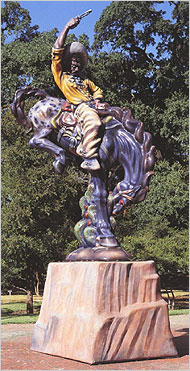 |
| VAQUERO - scroll down for photos of other artworks |
|
In Memorium
Luis Jimenez
1940 - June 13, 2006
Luis Jimenez, a sculptor whose color-splashed images of swirling dancers, roughneck cowboys in motion and the working class made him a controversial and easily recognized international figure in the art world, died Tuesday at his studio in rural Hondo, N.M. He was 65.
The Lincoln County Sheriff's Office in Carrizozo, N.M., said he died in an industrial accident.
Mr. Jimenez was pronounced dead at the Lincoln County Medical Center in southern New Mexico, the Lincoln County Sheriff's Office said. He sustained injuries when one of three pieces from a 32-foot-high sculpture being moved from his studio came loose and pinned him against a steel support. The piece, commissioned by Denver International Airport, depicted a giant mustang horse and had been in development for nearly a decade, according to Jim Moore, former director of the Albuquerque Museum.
Mr. Jimenez's massive fiberglass objects, depicting Hispanic and Native American dancers, cowboys and barrio workers with contorted faces and neon-colored, spray-painted clothing, are displayed prominently in public places and museums across the Southwest and the country. His work has been featured at the Art Institute of Chicago, the Museum of Fine Arts in Houston, the Metropolitan Museum of Art and the Whitney Museum of American Art.
The Smithsonian Institution in Washington, D.C., honored Mr. Jimenez's sculpture "Man on Fire" in 1979, when it became part of the Smithsonian's National Museum of American Art. The work, perhaps his best known, depicts a man in flames, and is based on the Aztec emperor Cuauhtémoc, who was burned alive by Spanish conquistadores. A casting of another of his sculptures, "Vaquero," which shows a bronco rider atop a shimmering, metallic-blue horse, sits outside the museum.
|
|
Mr. Jimenez was born in El Paso in 1940. His father owned an electric sign shop, which exposed Luis to spray painting and welding. He moved to New York in 1966, returned to New Mexico in the early 1970's and found success — and controversy — as a sculptor of outdoor objects, which are featured prominently around Albuquerque, including at the University of New Mexico, in the neighborhood Martineztown and in the National Hispanic Cultural Center.
Jimenez drew major attention, positive and negative, in 1983, when neighbors in the Old Town district in Albuquerque objected to a sculpture depicting a Native American caressing a dying woman, saying that it resembled a rape. More recently, Mr. Jimenez completed a sculpture of firefighters for the city of Cleveland, and was putting the finishing touches on the Denver International Airport piece, Mr. Moore said.
"At the height of Minimalism in the 1960's, he chose to do something out of fashion," Mr. Moore said. "His work contributed to the rise of Pop Art, but it was more a willingness to do something so overtly meaningful at first glance."
New Mexico's governor, Bill Richardson, ordered flags around the state to be flown at half-staff today and Friday.
Rudolfo Anaya, professor emeritus of history at the University of New Mexico, said of Mr. Jimenez: "The kind of medium he used shocked the art world at first. It was first called outlandish and garish, but it spoke not only to Hispanics but to the world. In the coming years there will be a school of Luis Jimenez art."
Ruidoso - Artist as Common Man
Scroll down for PHOTOS of Jimenez' artworks & additional articles & tributes.
|
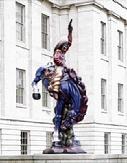 |
| Vaquero in Washington DC |
|
|
|
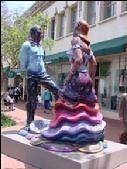 |
| Dancers |
|
|
 |
| Southwest Pieta |
|
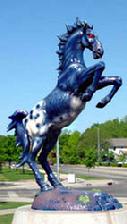 |
| Musteno |
|
|
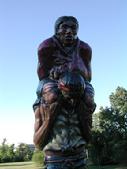 |
| Border Crossing |
|
|
|